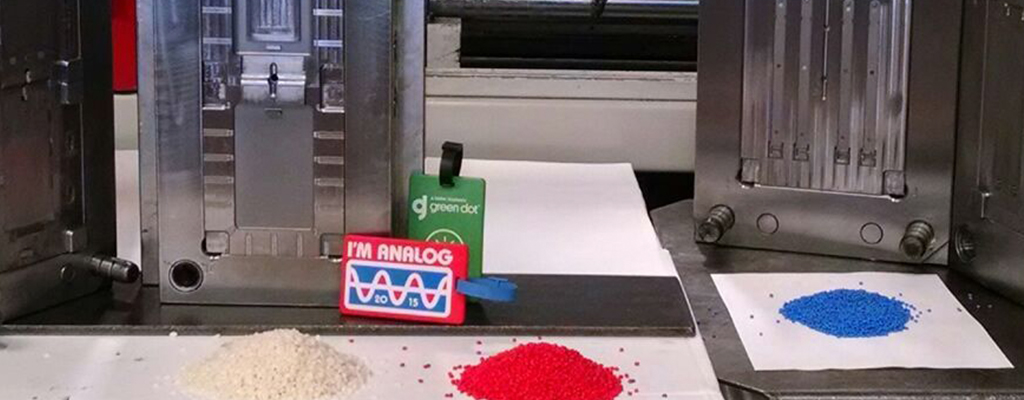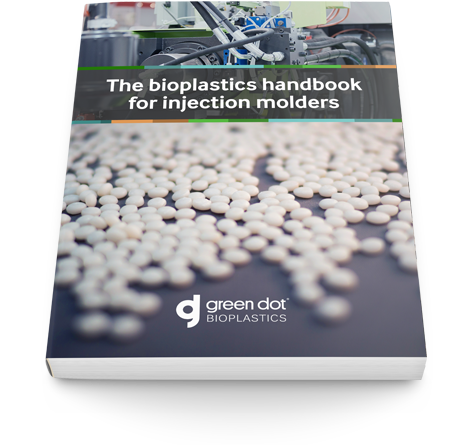Injection molders who have made bioplastics work

How has the relationship between injection molders and bioplastics changed?
Injection molders have had issues with bioplastics in the past because the materials were expensive and not compatible with existing equipment. These issues forced injection molders to purchase new equipment and even make fundamental and expensive changes to their processes. As a result, bioplastics now have a problematic reputation among injection molders, who are wary of using them in their facilities.
However, bioplastics have since evolved and can now seamlessly replace traditional petroleum-based plastics. The four injection molders we interviewed provided valuable and promising insights on what working with bioplastics entails. Although each had technical issues at the initial stages, they were eventually able to run the materials successfully in their respective facilities.
Matt Poischbeg, an injection molder at SEA-LECT Plastics, was enthusiastic about experimenting with different bioplastics due to the possible competitive advantages they could offer to customers. He found out about Green Dot Bioplastics five years ago at an outdoor retailer expo in Salt Lake City, Utah. Poischbeg said the company caught his attention because he “…was amazed that they had a flexible compostable plastic.” He had heard of compostable biodegradable plastics but had never seen elastomeric materials. Poischbeg experimented with the flexible compostable plastic material for kayak manufacturers but had to forgo the project due to a lack of demand.
However, he successfully developed a compostable luggage tag for Pearl Jam with Green Dot Bioplastic’s Terratek Flex (a biodegradable elastomer) and Terratek BD (a biodegradable bioplastic) and is eager to continue experimenting with different materials. Poischbeg’s enthusiasm parallels the prediction made by Plastics Today that biobased and biodegradable plastics will see an increase in global demand.
Should injection molders experiment with bioplastics?
While it is understandable why companies want to stick with established plastic materials, experimenting with new ones can be rewarding. Hal Alameddine, the President of Pike’s Peak Plastics, successfully worked with a Terratek Biocomposite composed of bio-based polyethylene derived from sugarcane and corncob fibers to develop Eco-Rigs for Begin Again Toys, which was licensed by John Deere. Alameddine said, “It’s a good material to run. We didn’t feel that we needed to make major adjustments to our current process with respect to running standard polyethelyne. This one was a little trickier because of the addition of the corncob into it. But in general, I would say it ran as well as any other material.”
Initial challenges are not uncommon. Reed Hardgrave, an injection molder at Ferguson Production, initially experienced some difficulty with bioplastic resins expressing desirable end properties. However, he eventually found success with a wood-plastic composite used to mold toys, replicating the aesthetics of wood.
Bioplastics suited for injection molding
There is now a wide range of bioplastic materials suitable for injection molding. Bioplastics are those plastics which come from biomass at the beginning of their life (i.e., bio-based plastics and biocomposites), those which biodegrade into biomass at the end of their life (i.e., biodegradable plastics), or both (i.e., biodegradable and bio-based). Bio-based plastics commonly used for injection molding include bio-based PET, starch-plastic composites and wood-plastic composites. Biodegradable polymers suited for injection molding include PBAT and PCL. PLA and PHA are examples of injection molding grade polymers which are both bio-based and biodegradable.
As with conventional plastics, bioplastics polymers can be alloyed and blended to achieve a wide array of physical properties, from enhanced tensile strength, flexural modulus or impact strength. PLA, for example, is generally thought of as a brittle material. A study revealed that PLA can be compounded with biodegradable thermoplastic elastomeric materials to modify the physical properties of PLA without compromising its compostability. At a ratio of 70% PLA and 30% biodegradable thermoplastic elastomer, the percent elongation increased 18.7%. At the same ratio, the impact strength of PLA increased by more than 400%. In this way, bioplastic material manufacturers often customize blends and alloys of common polymers to achieve the required performance characteristics of a specific product or application.
Technical considerations
Injection molders who are apprehensive about the compatibility of bioplastics with existing equipment can be confident that modern materials don’t require any inconvenient specifications.
Kevin Godsey, an injection molder at Mid-Continent Tool and Molding, Inc., made compostable dog-waste dispensers with a starch-based elastomer. He emphasized that although a lower temperature profile was required for the heat-sensitive elastomers, the adjustments weren’t beyond standard protocol. In fact, cycle times fell within the norm and even the drying times, which have been a pain point for injection molders, weren’t an inconvenience since he only had to account for surface moisture. Despite having initial challenges, Godsey stated that the material was still “moldable and very user friendly.”
What are some of the benefits of working with bioplastics?
Based on the experiences of the injection molders we spoke with, it is clear that the right bioplastic can be molded with minimal technical issues. Hence, it could be productive for injection molders to at least experiment with different bioplastic resins so they can determine for themselves if the materials are in fact user friendly.
Injection molders should think about experimenting and potentially working with bioplastics because:
- Modern bioplastics can be seamlessly incorporated into the injection molding process and no additional equipment is needed to accommodate the materials.
- They could diversify options for their customers, especially since Grand View Research found that bioplastics are projected to control 5 percent market share of the plastics industry by 2020.
- Bioplastics provide customers with unique advertising opportunities since the materials are Made in America and sustainable.
Small learning curve
Although bioplastics are compatible with existing molding equipment and processes, injection molders still need to experiment with different materials to figure out technical details such as cycle and drying times. Of course, this means the initial stages won’t be perfect.
However, each of the injection molders we interviewed emphasized that the learning curve was not steep and that they were ultimately able to run the materials with minimal hitches. For example, Godsey noted that scrap rates were somewhat high at the initial stages but quickly got them back within a standard ratio. When we asked Hardgrave if he had issues integrating bioplastics into his current operation, he noted that “venting is a big one. If [bioplastics] don’t vent, plating can become blackened.” Ultimately, Hardgrave was able to overcome his venting challenge and made accommodations for it whenever he was working with bioplastics.
Injection molders can now confidently experiment and eventually work with bioplastics and many are optimistic about the demand for the materials in the coming years.

The bioplastics handbook for injection molders
Get a straightforward discussion of processing best practices for bioplastics.


